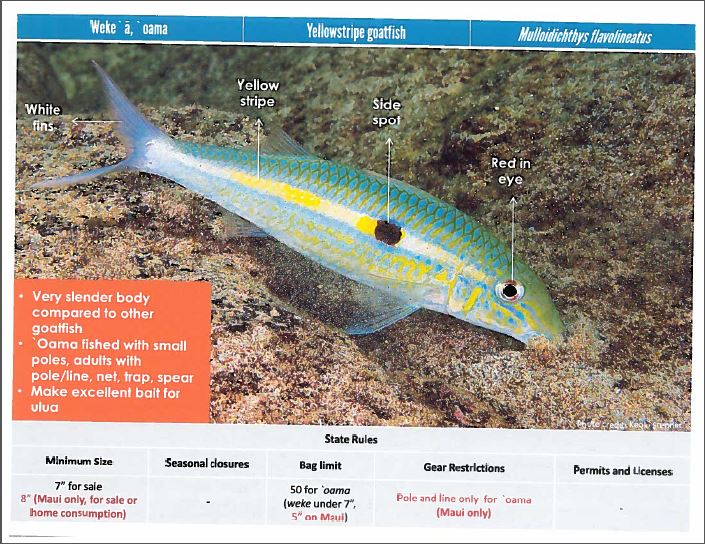Fine Issued for Use of Illegal Throw Net to Catch Oama

Oama. Photo credit: DLNR.
A $250 fine was imposed upon a defendant who was apprehended for using an illegal throw net to catch oama.
The fine stems from an October 2015 incident in which an off-duty officer with the Division of Conservation and Resource Enforcement observed the defendant catching oama with an illegal throw net at Maunalua Bay Beach Park on Oʻahu.
In addition to the fine imposed upon Keith Sonoda, the defendant’s net was also ordered for destruction as contraband fishing gear.
Under current laws, it is illegal for anyone to possess, use or offer for sale any throw net with a mesh of less than two inches stretched.
DLNR regulates the size of stretched mesh nets in order to ensure that smaller fish have a chance to escape when throw nets are deployed.
Violations of rules regulating gill net use are petty misdemeanors punishable through the imposition of fines or imprisonment. All net violations require a mandatory court appearance and the minimum fine for a first offense is $250.
“This type of case is a high priority for DOCARE,” said Jason Redulla, acting DOCARE enforcement chief. “In late summer, oama congregate in large schools along Hawaiʻi’s shorelines, where they are easily caught using hook and line. This schooling trait makes them very susceptible to take by illegal throw net,” Redulla added.
“Using a small mesh net, one fisher can wipe out the whole school,” he continued. “Any fish that are lucky enough to escape usually break up and fishers in that area will not see another school of oama until the following summer. Accordingly, this case was a high priority for us not just because the net was contraband, but also because of the manner in which it was used. I’d like to thank our DOCARE officer for volunteering his time on his day off to cite the individual, and I think it shows our dedication to resource conservation and pono fishing,” said Redulla.
Oama are juvenile weke, which are members of the goatfish family, and are an important species to anglers as they are excellent table fare, according to DLNR officials. In addition, large schools of oama in the late summer are an important food source for larger predators like papio, ulua and even green sea turtles.
Take of oama by hook-and-line fishers is limited to 50 per angler per day.
The public can report natural resources violations to DOCARE at 643-DLNR. Callers may also remain anonymous.










